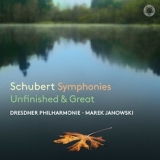Wer die beiden letzten Symphonien von Franz Schubert einspielt, sollte angesichts der erdrückenden Konkurrenz etwas zu sagen haben. In der Achten, der Unvollendeten, bleibt es bei Janowski und der Dresdner Philharmonie weitgehend bloß bei Routine. Das ändert sich grundlegend in der Neunten.
Im ersten Satz der Neunten, der großen C-Dur-Symphonie, fällt Janowskis entspanntes und betont lyrisches Dirigieren auf. Das unterscheidet ihn von den meisten rezenten Interpretationen, obschon es viele andere Dirigenten gibt, die auch ein gutes Stück mehr als 16 Minuten für diesen Satz brauchen. Janowski kann mit viel Liebe zum Detail und zu ganz netten Klangfiguren sowie dem schon erwähnten Lyrismus punkten. Großes Lob verdienen dabei die Holzbläser des Orchesters. Das Andante beginnt genau so leicht und unbeschwert wie der erste Satz endet. Das erlaubt es Janowski, den zweiten Teil umso schmerzlicher werden zu lassen und das Konfliktuelle gestisch weiterzuführen bis zum Höhepunkt, nach dem zunächst Ermattung und zarte Schwermut deutlich werden, bis dann die Musik wieder an Anmut gewinnt. Der dramaturgische Verlauf dieses Satzes ist Janowski wirklich tiefschürfend und packend gelungen.
Der dritte Satz wird nicht weniger inspiriert gespielt und das Finale eilt wohl schwungvoll und leicht dahin, aber die Musik wird nie banal, sondern in feiner Differenzierung, detailreich und transparent wirklich hörenswert.
Whoever records the last two symphonies of Franz Schubert should have something to say in the face of overwhelming competition from other recordings. In the Eighth, the unfinished one, Janowski and the Dresden Philharmonic largely remain merely routine. That changes fundamentally in the Ninth.
In the first movement of the Ninth, the great C major symphony, Janowski’s relaxed and emphatically lyrical conducting is striking. This sets him apart from most recent interpretations, even though there are many other conductors who also take a good bit more than 16 minutes for this movement. Janowski can score with a lot of attention to detail and quite nice textures as well as the aforementioned lyricism. The orchestra’s woodwinds deserve great praise in this regard. The Andante begins just as light and charming as the first movement ends. This allows Janowski to make the second part all the more painful and to continue the conflictual gesture until the climax, after which weariness and tender melancholy first become apparent, until the music then regains grace. Janowski’s dramaturgical development of this movement is truly profound and gripping.
The third movement is played no less inspiredly and the finale arguably rushes along buoyantly and lightly, but the music never becomes banal but in fine differentiation, rich in detail and transparency really worth hearing






















